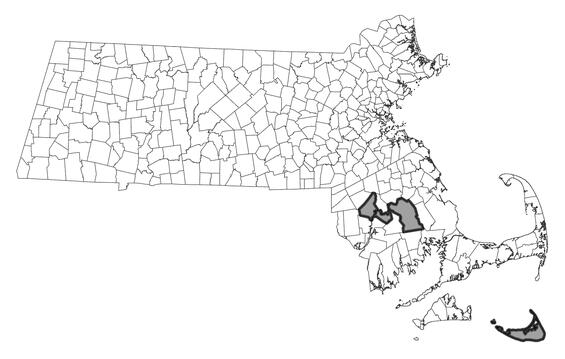- Scientific name: Eleocharis tricostata
- Species of Greatest Conservation Need (MA State Wildlife Action Plan)
- Endangered (MA Endangered Species Act)
Description
Three-angled spike-sedge is a tufted, perennial member of the sedge family (Cyperaceae). Unlike most sedges, which have solid, triangular stems, three-angled spike-sedge has flattened or compressed stems without leaf blades. Its stems are 20-60 cm (8-24 in) tall and may be erect or horizontal along the ground. This species spreads vegetatively by sending out stout, white underground stems (rhizomes) that produce roots and shoots at their nodes. Three-angled spike-sedge can grow in discrete clumps or cover areas like a mat.
To identify three-angled spike-sedge and other Eleocharis species, a technical manual must be consulted and mature fruit examined with a hand lens or microscope. The genus Eleocharis is characterized by a single “spike” of inconspicuous flowers at the top of the stem. The achenes (dry, single-seeded fruits) have a small projection (tubercle) on the top that varies in size, shape, and texture among species. Mature achenes of three-angled spike-sedge have very small tubercles, are triangular in cross-section with convex sides and no bristles. The achenes have “keel-like” angles where edges of the achene meet and form a ridge or wing. The rhizomes of three-angled spike-sedge have scales that are easily removed to reveal the firm, thick, white rhizome; this is the only New England Eleocharis with white rhizomes.
Although several Eleocharis species in the Northeast are generally similar in appearance, only three-angled spike-sedge has a white rhizome. Common spike-sedge (E. palustris) and bald spike-sedge (E. erythropoda) have lens-shaped or biconvex achenes rather than triangular. Robbin’s spike-sedge (E. robbinsii) may occur with three-angled spike-sedge but also has lens-shaped or biconvex achenes. Slender spike-sedge (E. tenuis) and elliptic spike-sedge (E. elliptica) have triangular achenes but the flowering spikes are smaller than those of three-angled spike-sedge. Engelmann’s spike-sedge (E. engelmannii) is not rhizomatous and has lens-shaped achenes.
Life cycle and behavior
This is a perennial sedge.
Population status
Three-angled spike-sedge is listed under the Massachusetts Endangered Species Act as endangered. All listed species are protected from killing, collecting, possessing or sale, and from activities that would destroy habitat and thus directly or indirectly cause mortality or disrupt critical behaviors. The MassWildlife’s Natural Heritage & Endangered Species Program has 3 records from 2 counties: Nantucket and Plymouth. All 3 records have been observed within the last 25 years.
Distribution and abundance
Three-angled spike-sedge occurs along the Atlantic Coast from Massachusetts to Florida to Louisiana. It also occurs in Michigan. It was previously known from Pennsylvania, where it is now presumed extirpated (no longer occurring in the state). It is also possibly extirpated from Rhode Island where it has not been observed for many years and was never observed in Connecticut.

Distribution in Massachusetts. 1999-2024. Based on records in the Natural Heritage Database.
Habitat
Three-angled spike-sedge is found on gently sloping coastal plain pond edges in years when water levels are low and there is exposed shoreline. Three-angled spike-sedge is typically found in low nutrient, sandy or peaty soils along coastal pond shores. Although three-angled spike-sedge can occur in the upper, middle, and lower shores, it is most often found in lower areas where the shoreline may not be exposed for many years. Examples of plants found growing in association with the three-angled spike-sedge include pondweeds (Potamogeton spp.), needle spike-sedge (E. acicularis), tupelo (Nyssa sylvatica), creeping St. John’s wort (Hypericum adpressum), slender goldentop (Euthamia caroliniana), and three-way sedge (Dulichium arundinaceum).
Healthy habitats are vital for supporting native wildlife and plants. Explore habitats and learn about conservation and restoration in Massachusetts.
Threats
Threats to three-angled spike-sedge include water withdrawal, eutrophication, and invasive plants.
Conservation
Little is known about the life history of three-angled spike-sedge, and locating populations can be challenging due to fluctuating water levels. Natural hydrological conditions should be protected at sites supporting three-angled spike-sedge and other coastal plain pond species. Proper septic system maintenance, restrictions on fertilizer use, and management of road run-off are needed to reduce the risk of eutrophication (nutrient enrichment) of coastal plain ponds. Populations of three-angled spike-sedge should be monitored for exotic plants. If they are competing with rare species, a removal or management plan should be developed in consultation with the MassWildlife’s Natural Heritage and Endangered Species Program. All active management of state-listed plant populations (including invasive species removal) is subject to review under the Massachusetts Endangered Species Act and should be planned in close consultation with MassWildlife’s Natural Heritage & Endangered Species Program.
Contact
| Date published: | May 7, 2025 |
|---|